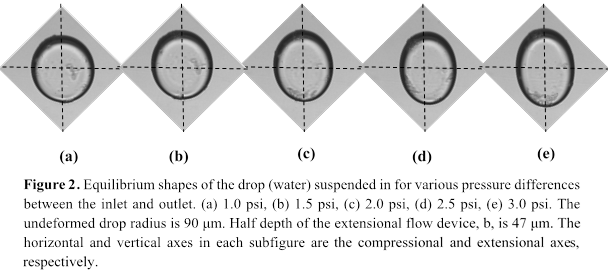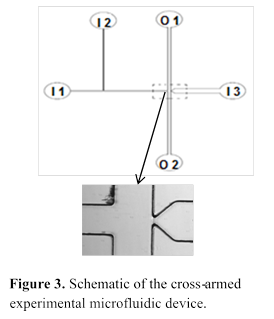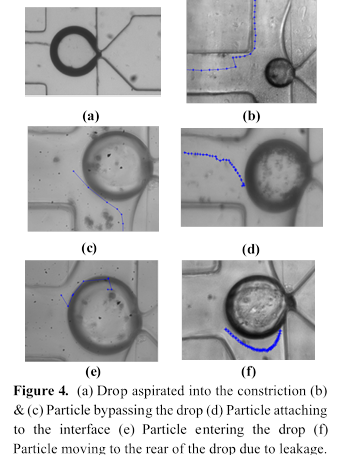58th Annual Report on Research 2013 Under Sponsorship of the ACS Petroleum Research Fund
Reports: ND952539-ND9: Fundamental Studies of the Removal of Particulate Fines From Solvents Using Water Droplets as Collector Particles
Arun Ramchandran, University of Toronto
1. PROJECT OVERVIEW
2. EXPERIMENTS
2A. Extensional Flow device:
A computer-controlled extensional flow device was developed for trapping and manipulating particles purely by hydrodynamics. The device comprises a diamond-shaped slot connected to four pressure-controlled reservoirs (Fig. 1). Liquid enters the slot through the oppositely-positioned inlets I1 and I2, and leaves through a second pair oppositely-positioned ports, O1 and O2; this produces a stagnation point within the slot. By manipulating the relative pressure in the reservoirs, the stagnation point can be adjusted to any desired point in the slot. This allows us to push a particle that may be present in the slot to the center of the slot. A computer images the particle, and predicts the pressures required to be set in the reservoirs to move the stagnation point to the position that results in a particle velocity directed towards the device center. A particle can be retained at the center to a precision of 200 nm.
The device was validated by measuring the interfacial tension of a mineral oil-water system. A droplet was trapped at the device center, and the drop shape was recorded with increasing strain rate (Fig. 2). The interfacial tension was determined by a formula based on an analytical theory that connects the drop deformation with strain rate to interfacial tension. A comparison of this interfacial tension to that measured using a spinning-drop tensiometer gave excellent agreement. A manuscript detailing the construction, calibration and validation of this device co-authored by Shashi and another graduate student will be submitted within the next two months to Lab-on-a-chip.
2B. Microfluidic aspiration device:
Fig. 3 shows a schematic of the microfluidic aspiration device. The continuous phase flowing through I1 intersects the drop-phase fluid from I2 at the T-junction, forming dispersed phase drops. Drops of desired size can be formed by adjusting the oil-to-water flow rate ratios.
A single drop is trapped at the constriction by applying suction at the inlet I3 [Fig. 4(a)]. The pressure in port I3 is adjusted relative to the other ports to hold the drop firmly. The outlet ports O2 and O3 are connected to reservoirs open to the atmosphere. Once the drop is held firmly by suction, particles introduced into the suspending fluid impinge on it. Our initial experiments have been implemented with mineral oil (0.8 g/cc, 30 cp at 25 °C), DI water and glass beads. The microfluidic device was fabricated in PDMS and bonded using plasma treatment. The device was rendered hydrophobic by silanization so that water droplets are formed easily in the device. Also, the rectangular cross-section of the device was made circular so that particle escape through the corners of the cross-section occupied by the aspirated drop may be minimized.
Results: Fig. 4 shows the different trajectories of a particle brought towards the drop by the flow as calculated using an image analysis code written in MATLAB. For these preliminary experiments, we found that the particles rarely entered the drop, for the simple reason that spatial range of the inlet streamlines for which our small particles (11 um) are expected to approach the drop for capture to take place is very narrow. This can be remedied by increasing the particle size or the drop size for a fixed microchannel geometry. We also experienced some technical difficulties, such as particles entering the drop after circulating around it [see Fig. 4(f)], which is occurring due to inadequate modification of the rectangular cross-section to a circular one; we are currently working to improve the modification procedure. Another difficulty is that the drop breathes because of fluctuations in the pressure, currently controlled manually. This causes the particles change their path abruptly [e.g. see Figs. 4(b) and 4(e)]. We are now switching from a manual control to an electronic pressure controller for aspirating the drop.
Future Work: Our plan for the next year is to use the drop-trapping setups to delineate the particle-drop collision efficiency as a function of the shear rate, drop size, particle size, fluid viscosities and interfacial properties
3. SIMULATIONS
Another Masters student, Rohit Sonthalia, is working on boundary integral (BI) simulations of the process of entry of a particle into a drop. Since Rohit has no prior experience in these simulations, the PI has introduced him to this technique by having him work through four elementary BI problems involving single drops or single particles in simple flow fields. Currently, Rohit is working on two problems: (a) The approach of a spherical particle towards a liquid-liquid interface to study the drainage dynamics (b) The stretching of a Janus drop in an extensional flow field, which is a simple starter problem that will provide the group with the capability of handling three phase contact lines within the BI framework.
Copyright © 2014 American Chemical Society















